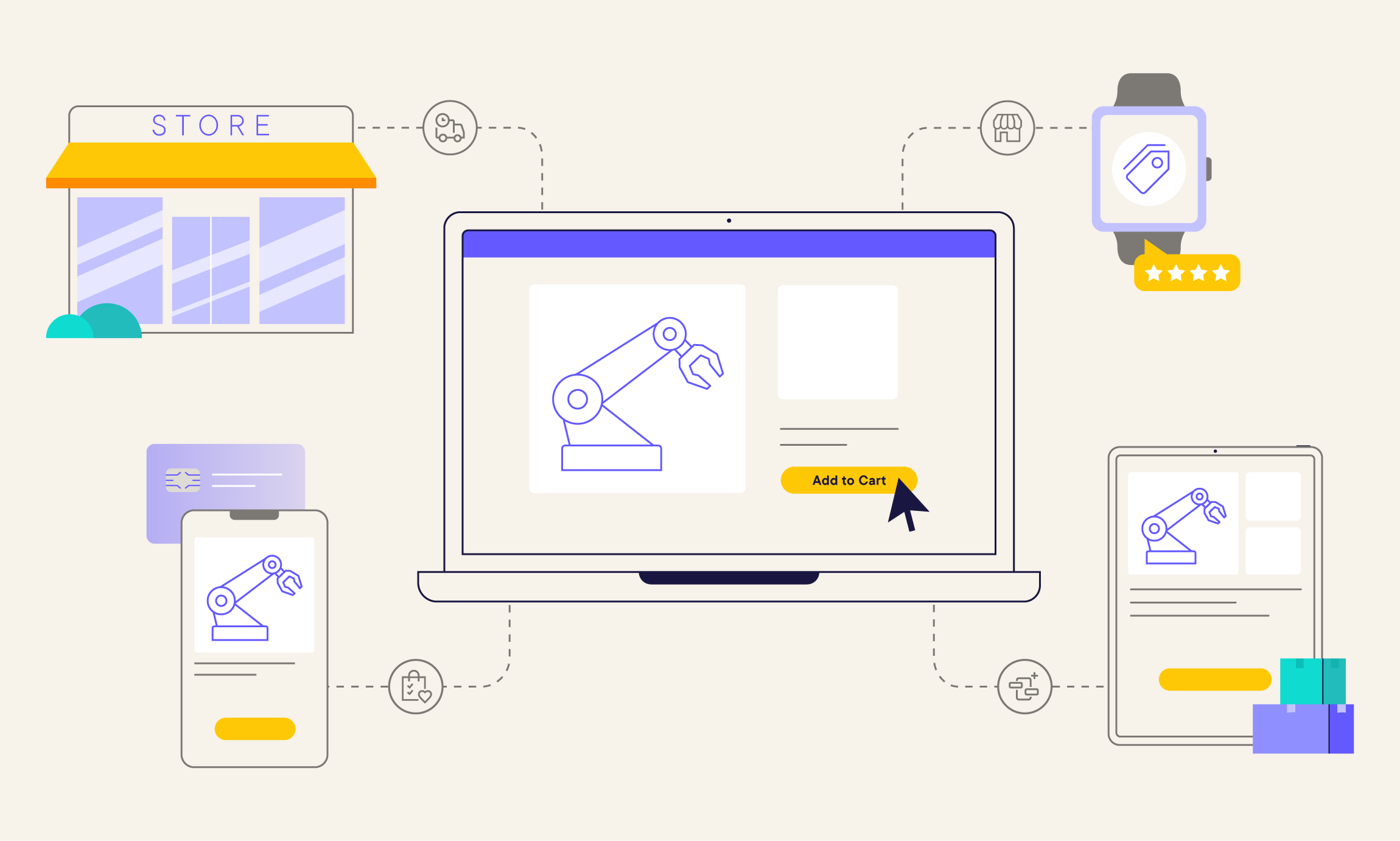
How forward-thinking B2B businesses, especially manufacturers, are using composable commerce to diversify business models without fragmenting their eCommerce footprint.

Traditionally, companies have been categorized by the sales model they employ, such as B2B (business-to-business), B2C (business-to-consumer) and D2C (direct-to-consumer). However, as you may have noticed or even experienced first-hand, the reality is that companies are operating differently today. In fact, many businesses don’t fit into a single description anymore — and the ones that do are probably considering diversifying. After all, it’s clear that a company can be (and sometimes should be) B2B, B2C, B2B2C and D2C.
Quite a few B2B companies have already discovered the benefits of diversifying, with many eagerly flirting with B2C and D2C strategies.
While a business-model-agnostic approach isn’t new, the COVID-19 pandemic was the catalyst that forced B2B businesses to shift sales to eCommerce. Once B2B firms have their eCommerce running smoothly and they’re reaping the benefits, it only makes sense to look beyond — and realize the immense opportunities of diversification.
Quite a few B2B companies have already discovered the benefits of diversifying, with many of them eagerly exploring opportunities and flirting with B2C and D2C strategies.
While a business-model-agnostic approach isn’t new, the COVID-19 pandemic was the catalyst that forced B2B businesses to shift sales to eCommerce. Once B2B firms have their eCommerce running smoothly and they’re reaping the benefits, it only makes sense to look beyond — and realize the immense opportunities of diversification.
Why companies operating across business models still face issues with disparate eCommerce systems
Even as the lines between B2B, B2C and D2C become blurry, each model has specifics that can't be ignored, which impact how eCommerce is designed, implemented and managed.
For instance, B2B buyers increasingly require a convenient and pain-free experience similar to consumer-grade shopping. Most also have long-standing relationships with their suppliers and want to place recurring orders as well as receive volume discounts.
On the other hand, consumers are less likely to repeat purchases of non-commoditized products. Instead, they’re driven to purchase based on seasonality, instant gratification, promotions, pick-up and delivery options, free shipping, etc. Brands that deliver to these expectations are rewarded with customer loyalty.
These distinctions translate into dedicated marketing strategies, buying processes, storefront design, pricing logic, customer experience and loyalty programs that companies must address for each business model. At the same time, they shouldn’t discard the synergies that exist — such as between product data, catalogs, inventory and checkout.
The first inroads into multi-model eCommerce replicated those differences and ignored the synergies. Characterized by unwieldy systems of old, also known as monoliths, companies using them discover they come with limitations that effectively make it impossible to support multiple business models on a single platform. The result? Companies deploy one eCommerce system per business model, creating operational silos and IT fragmentation, leading to inconsistent product, pricing and customer data across their eCommerce footprint.
In addition, disparate technologies inflate the associated licensing fees, add-ons, services and customizations. These costs grow year on year into a bloated TCO (total costs of ownership) that’s far too expensive to maintain and invest over time. It’s clear that implementing separate systems for each and every business model isn’t a sustainable strategy.
The technological foundation for multi-model strategies is composable
Composable commerce helps B2B companies, particularly manufacturers, accomplish this: Consolidating all commerce interactions across all business lines in B2B, B2B2C and D2C in one technology stack. A unified commerce platform ensures seamless data integration across models, preserving synergies in product information, customer data and checkout processes, while enabling distinct storefronts and marketing strategies.
commercetools enables businesses to manage B2B, B2C and D2C models on a single platform through its composable architecture. Supported by a multi-brand approach, businesses can leverage commercetools’ concept of “stores and channels” to differentiate the customer-facing experience while operating from a unified backend.
This setup allows businesses to define what a “store” represents — whether it’s physical locations, online stores or different business lines — allowing for a streamlined and scalable management system across various business models. In other words, this flexibility ensures that businesses can support diverse needs without duplicating efforts while centralizing data management and reducing costs associated with maintaining multiple systems.
Leaders blending B2B and B2C/D2C
A global producer of food and beverages, Danone leverages composable commerce to support
B2C, D2C and B2B business models using one commerce engine. The B2C-first manufacturer
made its first inroads into D2C to address the COVID-19 pandemic in 2020, enabling distressed parents to find the right nutrition products for their babies directly on Danone’s website.
The France-based company’s healthcare division in the UK uses the same commerce solution for B2B customers to order medical samples directly from Danone, streamlining the customer experience while gathering key data on how these customers use its products. With a centralized product catalog across all business units, markets and brands, Danone can perform a hyper-local strategy that crafts experiences according to local market needs without losing sight of the global brand and its products.
Tamron, a Japan-based global manufacturer of camera lenses, has historically sold its products through distributors, local dealers and online platforms like Amazon. The European subsidiary, Tamron Europe, learned through a customer journey analysis that consumers visited its website wanting to purchase products, which led to the decision to integrate a complementary webshop to serve consumers directly.
The manufacturer started rolling out the online store in Germany and Austria, expanding to 27 European countries soon after. Thanks to the flexibility of composable architecture, Tamron works closely with distributors in its D2C approach by giving them access to the Merchant Center (commercetools’ business tooling) to run localized promotions. This way, the company enables collaboration across the distribution chain to uplift revenue and customer experiences.
The premier power tools manufacturer Festool also adopted a D2C strategy to sell directly to tradespeople in timber construction, carpentry, painting and renovation work. The company observed a trend where customers discovered their products predominantly online, often from Festool’s website, and proceeded to make purchases in marketplaces or specialized retailers. In addition, as the company boasts an extensive product range of over 2,700 products, it’s impractical for any retailer to list and stock all these items for immediate purchase.
Festool established a D2C store using a composable architecture, leveraging its flexibility and scalability. Plus, it has automated all processes and customer communications within five months, making the company more efficient and customer-driven. The company surpassed its internal sales goals by 150% in the first year since implementing a D2C store.
Starting your multi-model journey with commercetools
Whether you’re just starting your digital transformation or exploring ways to expand your eCommerce to B2C/D2C without fragmenting your tech stack, commercetools Composable Commerce is the right solution to pivot between B2B, B2C and D2C without missing a beat.
Start your multi-model journey with a leading composable commerce solution that offers an API portfolio and data models recognized by big-name analysts such as Gartner and B2B Paradigm. Armed with a flexible technological foundation, you can future-proof your business no matter where you’re headed next.
